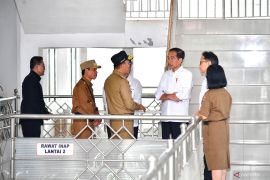"This is expected to raise public and international confidence in the government`s efforts to conserve the world`s rare species," Forestry Minister Zulkifli Hasan said.Jakarta (ANTARA News) - A Sumatran rhino has given birth to a male calf at the Sumatran Rhino Sanctuary (SRS) in the Way Kambas National Park in Lampung.
The birth at 00.45 hours on Saturday was the first since breeding conservation started in Asia 124 years ago, making it a historic milestone in Sumatran rhino conservation, Forestry Minister Zulkifli Hasan said, announcing the birth here on Monday.
"This is expected to raise public and international confidence in the government`s efforts to conserve the world`s rare species," he said.
The calf was born to male rhino Andalas (12), born in Cincinnati Zoo in the US in 2001, and female rhino Ratu (12), from Way Kambas.
Ratu twice got pregnant from the same partner, but she had miscarriages.
Andalas was sent here from Cincinnati in 2007 and paired with Ratu.
During the period of Ratu`s pregnancy, for 15-16 months,the mother and calf have been monitored closely by a team of nurses and doctors from the Indonesia Rhino Foundation (YABI) and the Indonesia Safari Park, as well as veterinarians from the International Rhino Foundation (IRF) of the Cincinnati Zoo, Tarongan WPZ Australia and White Oak Conservation Center of America.
The pregnancy and delivery have been documented for evaluation purposes, the minister said.
Visits to the SRS were limited to avoid possible disruptions, especially before the birth, he said.
Presently,, Indonesia has two Asian rhino species out of five species remaining in the world; the Javanese rhino with a population of around 50 and Sumatran rhino with a population of 200 in Way Kambas, Bukit Barisan Selatan, Mount Leuser and several other natural forest regions in Sumatra and Sabah, Malaysia.
The two rhino species are the rarest and facing extinction due to depletion of their habitat and poaching.
The International Union for the Conservation of Nature and Natural Resources (IUCN) had placed the two species under the category of critically endangered in 2006.
"The existence of the two rare species places the responsibility on us with regard to their conservation," the minister said.
He added that the protection of the species had already been formulated in the forestry ministry regulation Number 43 of 2007 on strategy and action plans for rhino conservation for 2007-2017.
The regulation has been implemented through various conservation activities by the directorate general of forest protection and nature conservation and its partners, such as YABI and IRF.
The SRS is an area for the conservation program measuring 100 hectares and is surrounded by electric barbs 1.5 meter high and is provided with adequate facilities.
The conservation program at Way Kambas is expected to be used as a model for the implementation of the Java Rhino Study Conservation Area (JRSA) for Janavese rhino conservation at Ujung Kulon National Park.(*)
Editor: Heru Purwanto
Copyright © ANTARA 2012











